
|
![]()
Greatest Films of the 1920s
1920 | 1921 | 1922 | 1923 | 1924 | 1925 | 1926 | 1927 | 1928 | 1929
Title Screen Film Genre(s), Title, Year, (Country), Length, Director, Description 



The Cameraman (1928), 69 minutes, D: Edward Sedgwick, Buster Keaton
Co-director/actor Buster Keaton's classic, slapstick dramatic comedy (of eight reels) was his first film (in a two-year deal) with a major studio - MGM. It had a remarkable number of clever and hilarious set-pieces. In the main story, humble, vendor-photographer was selling 10 cent tintype portraits on a NYC sidewalk. The infatuated Buster (aka Luke Shannon) (Buster Keaton Himself) aspired to become an acclaimed newsreel-cameraman to win over pretty MGM secretary Sally Richards (Marceline Day) who worked in the studio's News Reels division with newsreel MGM cameraman Harold Stagg (Harold Goodwin) under their MGM boss Edward J. Blake (Sidney Bracey). Buster first met MGM employee Sally (and became infatuated with her) when he was interrupted by an MGM camera crew (including Harold) during his day job of taking tintype photos on the street. Harold was Buster's rival for Sally's courtship and affection and often mocked Buster's attempts at impressing Sally. To acquire a job at MGM to be closer to Sally, Buster purchased an obsolete, battered, hand-cranked Pathe silent-film movie camera for a trial interview. Buster's first stop was a visit to an empty Yankee Stadium, where he fully-improvised a pantomimed one-man baseball game. When Buster's first test film reel was screened for the MGM bosses, he became embarrassed that his footage was double-exposed, or sometimes running backwards or at tilted angles. Buster was dismissed from the screen room, and forlornly left the MGM News Reel office. On a Sunday, Buster and Sally went on a date to the Municipal Plunge - an indoor public swimming pool, where in the small-scale, men's dressing-room in the crowded bathhouse, he was confronted in one of the tiny cubicle-booths by a burly man (Edward Brophy) who wasn't willing to compromise and share the small space. Later, to help Buster, Sally tipped him off in the film office to a holiday celebration in Chinatown; he promised her that he would film the event, and shot exciting footage of an outbreak of a dangerous Tong War with machine gunfire between two gangs. However, back in the MGM office, Buster realized that he had accidentally forgotten to load his camera with a film cartridge. Sally was reprimanded by the boss for aiding the clumsy and foolish Buster. The next day at the Westport Yacht Club Regatta, Sally had joined Harold in his boat for the competition; Buster had decided to cover the regatta, and while rowing on the water, he accidentally discovered the missing film reel footage in his rowboat (it had been switched by his pet hurdy-gurdy monkey). He set up his film camera on the shore and happened to film Sally being thrown from Harold's boat into the water during a rapid turn. Buster redeemed himself by rowing out and rescuing the drowning and unconscious Sally from being hit by Harold's circling runaway boat. However, the duplicitous Harold unfairly took credit for rescuing and saving Sally. Buster returned to the scene, and watched sadly as a thankful Sally walked off in Harold's arms - and didn't realize that his monkey on-shore was hand-cranking the action. He offered his film cartridge to the MGM boss and returned to his old tintype photo job. The screening of Buster's footage included both the Tong War and the river-rescue footage. The film concluded with Buster's vindication and redemption in Sally's eyes - he had proven himself to be a capable cameraman. She excitedly told him a reception was being planned to honor him: "Everybody's talking about you! They're all waiting to give you a great reception!" Buster misinterpreted and thought that a ticker-tape parade in progress was being held for him, but instead it was to celebrate famed aviator Charles Lindbergh in 1927.



The Circus (1928), 72 minutes, D: Charles Chaplin
Writer/director/actor Charlie Chaplin's bittersweet, classic slapstick romantic comedy, with numerous pratfalls and gags, was an underrated, overlooked and captivating award-winning silent film. Chaplin starred as The Tramp (in the third-to-last Tramp film, and the last one during the silent era). The setting for the film was a failing big-top circus, run by a mustached, brutish and despotic proprietor Ringmaster (Al Ernest Garcia). One of the performers, trick-riding equestrienne Merna (Merna Kennedy), was the owner's abused stepdaughter. Others included a group of five overweight, unfunny and elderly clowns led by a sad-looking 'Old Clown' (Henry Bergman). The down-on-his-luck, "hungry and broke," destitute TRAMP (Charlie Chaplin) hobo character was introduced outside the circus tent in the midway area with side-shows. A wily pickpocket-crook (Steve Murphy) was able to implicate the falsely-accused Tramp as the thief with purloined goods (a stolen wallet and pocketwatch). The incident evolved into a frantic chase involving the Tramp, the pickpocket and the cops into a hall of mirrors (Mirror Maze). The Tramp was chased out of the Maze into the circus's main show-tent. There, the Tramp inadvertently became part of the big-top circus entertainment show, upstaging the boring, elderly clowns who were being ignored, booed and assaulted with cat-calls. The audience thought he was one of the hilarious show-acts. Shortly later, the Ringmaster recognized the resting Tramp in a chariot as his "Funny Man," and immediately offered the Tramp the possibility of a job and requested that he audition the next morning. The Tramp struggled during his audition-tryout with the other elderly clowns, when he was commanded: "Go ahead and be funny." The Ringmaster denounced his failed formal audition performance: ("That's awful!"), but then hired him as a props man instead of as a clown, and paid him low wages when his other props workers went on strike. The Ringmaster finally noticed that the Tramp was the hit star of the circus and exploited him: "He's a sensation but he doesn't know it, keep him on as a property man." The Tramp accidentally sought refuge in a cage with a sleeping lion (in addition to an annoying barking dog outside who threatened to awaken the beast) - he found himself locked inside, and an escape route through an open door led unfortunately to an adjacent cage with a growling tiger. When The Tramp was told by Merna that he was "the hit of the show...All the crowds, all the applause is just for you," the Tramp negotiated for higher pay, but Merna was reprimanded for alerting him. A love triangle developed between the Tramp, Merna, and the handsome, new "added attraction" - high-wire tight-rope walker-performer Rex (Harry Crocker) - King of the Air - wearing a top hat and tails. The rejected Tramp's mood changed, and his center-ring act was not well received. The Ringmaster noticed: "What's the matter? You hardly got a laugh." The dejected Tramp's performances were not improving, unfortunately, and he was warned by the Ringmaster: "You get one more chance." In a stunning set-piece sequence, the Tramp was called upon to substitute as Rex's replacement when he was a no-show. On the tightrope, with the aid of the safety wire, the Tramp was able to out-perform Rex with miraculous, daredevil feats of balance, but then the strap around his waist broke free - and he no longer was protected from a fall. As he crossed the tightrope, his act became even more challenging when escaped wild monkeys climbed up onto his head and bit his nose, pulled on his pants to remove them, and put their tail into his mouth. Fortunately, he was able to extricate himself and safely return to ground level. When the Tramp again saw the Ringmaster slapping and beating up Merna, he defended her by assaulting the Ringmaster - and was promptly fired. He and runaway Merna both retreated to the nearby woods to cook up another hobo meal under a moon-lit sky together. To protect Merna from his lonely and vagrant life-style, the Tramp - in a noble gesture - briefly returned to the circus and negotiated for Rex to marry Merna. After their ceremony the next morning, the Tramp tossed rice into the air and onto the happy couple as they kissed, to celebrate their marriage. The circus was ready to leave town after the show ended its run. The newlyweds Merna and Rex returned to the circus and confronted the Ringmaster, and he agreed to take them back together as a performing couple, but only reluctantly allowed the Tramp to rejoin - "The end wagon for you." In the film's melancholy conclusion, as the horse-drawn circus caravan wagons packed up and moved out, the heartbroken and rejected Tramp deliberately remained behind in a cloud of dust. With an iris fade-out ending in blackness, the solitary Tramp shrugged and then walked in the opposite direction, shuffling away with his trademark jaunt into the distance while spinning his cane with his left hand.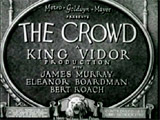




The Crowd (1928), 90-104 minutes, D: King Vidor
This was one of director King Vidor's greatest silent films - it was about 'average Joe' or "Everyman" characters who struggled to attain the American dream. The bleak, poignant, and realistic tale was the story of two young people, John Sims (James Murray) and Mary (director Vidor's wife Eleanor Boardman) who met, fell in love after a blind date (and fun trip to Coney Island), married, and honeymooned at Niagara Falls. It began with John's birth on the Fourth of July, 1900, his tough childhood, and his eager and desperate-to-please struggle to make it in New York City. As a lowly city clerk in a dead-end job, he and his wife (and family) struggled. A low point came when their young daughter was tragically killed in a truck accident in front of their tenement. Depressed and without a job, he considered suicide as an option, but ended up as a sandwich-board advertiser. In the final scene, he was reunited with Mary and they found happy, mundane anonymity and laughter amidst a huge crowd in a vaudeville theatre.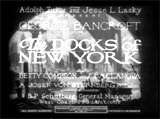





The Docks of New York (1928), 76 minutes, D: Josef von Sternberg
A silent film melodrama of love and redemption from von Sternberg with shadowy black and white visuals, pathos, genuine squalor, and an amoral tone. Blue-collar, salty, tattooed New York waterfront dock worker and steamship stoker Bill Roberts (George Bancroft) was given one night of shore-leave. He was on his way to a night of drinking at the Sandbar, a rough-and-tumble bar near the New York wharf on the East River. Next came a life-changing event - he saved the life of suicidal, depressed, hard-living, yet sassy dance-hall girl Mae (Betty Compson) who had thrown herself into the river. After stealing replacement clothes for her, he promised to be her savior and protector, and drunkenly and hastily proposed to her on a lark. After a makeshift, farcical marital ceremony held in the bar in front of leering patrons, the question remained - would the well-meaning intentions of Bill last? His major obstacle was Andy (Mitchell Lewis), the ship's third engineer who was unhappily married to Mae's best friend, Lou (Olga Baclanova). Andy was competing for Mae's affection, and fired Bill from his job the next morning - followed by ominous gunshots.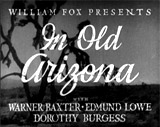

In Old Arizona (1928), 95 minutes, D: Irving Cummings
Advertised as an "100% All -Talking Fox Movietone Feature" - and historically important as the first talkie Western film produced by a major studio. It was also the first full-length talkie film to be shot outdoors (on location) and not in a studio. The story was suggested by The Caballero's Way, a 1904 short story by William Sidney Porter (O. Henry). Silent screen star Warner Baxter won a Best Actor Academy Award as the dashing, guitar-playing western troubadour and outlaw hero Cisco Kid ("the Robin Hood of the Old West") in Fox-Movietone's primitive film. [Note: This was the film during which co-director Raoul Walsh lost an eye.] The Cisco Kid's love interest in the western was poor, feisty Mexican girlfriend Tonia Maria (Dorothy Burgess), while he wasn't being pursued by tough US Army Sergeant Mickey Dunn (Edmund Lowe) who was also womanizing Tonia on the side- creating a love triangle when she was tempted to collect reward money to turn in the Kid. The western had stereotypical elements, including a gunfight, a stagecoach robbery, a cattle roundup - and a twist ending.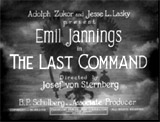


The Last Command (1928), 80 minutes, D: Josef von Sternberg
A silent film classic. After the great Russian Revolution of 1917, arrogant Imperialist Russian General Dolgorucki/Sergius Alexander (Best Actor-winning Emil Jannings), commander of Czarist troops, was forced to flee Russia, and came to America. He found his way to Hollywood, working on a Hollywood movie lot as a Hollywood extra, making only $7.50/day. He was cast as a Russian general in a film about the Russian Revolution, interestingly, and was humiliated under the direction of another ex-Russian Lev Andreyev (William Powell), a former impoverished actor/revolutionary who suffered under the general's whip. In acting out the role of the Russian general, the elderly man relived his past, but it was too much for him and he fell dead.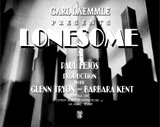



Lonesome (1928), 69 minutes, D: Paul Fejos



October (Ten Days that Shook the World) (1928, Soviet Union) (aka Oktyabr, or Октябрь), 95 minutes, D: Grigori Aleksandrov, Sergei M. Eisenstein
A brisk documentary-styled historical film (with Eisenstein's characteristic montages) that was commissioned to be made in 1927 as a propagandistic film to celebrate the 10th anniversary of the 1917 October Revolution. Notable for its cross-cutting, spectacular crowd scenes and startling close-ups, and authentic look (often mistaken for actual historical newsreel footage of the revolution). It opened with events in St. Petersburg, beginning with the overthrow of the Romanov (Alexander III) monarchy in February of 1917. It also re-enacted the historic week-and-a-half in October 1918, when Kerensky's provisional regime was toppled by the Bolsheviks. The film was based on John Reed's Ten Days That Shook the World, recreated in Warren Beatty's Reds (1981).
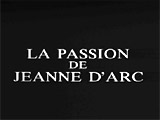




La Passion De Jeanne D'Arc (1928, Fr.) (aka The Passion of Joan of Arc), 110 minutes, D: Carl Theodor Dreyer
This silent film masterpiece featured French theatre star Renée Maria Falconetti (in her final fllm role) as the martyred title character in an authentic retelling of the story of the martyrdom of Joan of Arc. She had closely-cropped hair and was forced to endure imprisonment, an inquisition trial, torture, and execution at the stake by fire in the year 1431. The startling, ground-breaking and influential film used minimal sets, extremely oblique and other unusual camera angles, and excruciatingly huge close-ups to create a virtually new visual language soulfully expressive of the martyr's suffering psychology.Lost Film
The Patriot (1928), D: Ernst Lubitsch
A presumed lost film. An historical melodrama, and considered sexually-suggestive in its day. Promotional materials advertised the film's plot: These Characters Will Fascinate You! EMIL JANNINGS - Cruel, brutal, but also pathetic. The mad Czar who holds all Russia in his tyrannical grasp. FLORENCE VIDOR - An exotic beauty of the court. The Czar's favorite! Betrayed by her lover, she becomes a thorn in the hands of the conspirators! LEWIS STONE - Prime Minister and trusted friend of the mad Czar, who conspires against the monster ruler of Russia. NEIL HAMILTON - Heir to the throne. Worshipped by the Russians. The only man who can hold the government from self-destruction. In the story, the Czar's chief advisor (Prime Minister) and friend Count Pahlen (Lewis Stone), plotted to assassinate the cruel, lascivious and brutal despot Czar Paul I (Emil Jannings) - for the good of the country.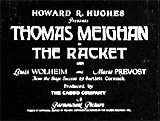



The Racket (1928), 84 minutes, D: Lewis Milestone
A difficult film to view - a long-lost but rediscovered film, and a forerunner of a rash of gangster films in the 1930s. A Best Picture nominee and solid crime-gangster silent film (produced by Howard Hughes), that was remade in 1951 (with Robert Ryan and Robert Mitchum). Well-connected (eluding capture with protection from politicians and city officials), influential and powerful Chicago bootlegger Nick Scarsi (Louis Wolheim) was the major rival-enemy of determined, and honest local Police Captain McQuigg (Thomas Meighan) and later, district attorney Welch (Sam De Grasse). In a subplot, Nick was opposed to the romantic involvement of his younger brother Joe (George E. Stone) with gold-digging, cynical blonde moll-singer Helen Hayes (Marie Prevost), but was unable to prevent their relationship. To get even, eye-witness Helen threatened to inform the police that Joe (arrested for killing a pedestrian in a hit-and-run car accident) was Nick's brother. At the same time, Nick was in hot-water for killing a police officer.



Spies (1928, Germany) (aka Spione), 90 minutes, D: Fritz Lang
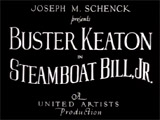



Steamboat Bill, Jr. (1928), 71 minutes, D: Buster Keaton, Charles "Chuck" Reisner
This movie was used as a model for Steamboat Willie (1928), Mickey Mouse's first animated cartoon with sound. Buster Keaton (in his second-to-last silent feature film) played William Canfield, Jr. - an effeminate college boy (with beret, ukulele, and thin mustache), who returned home to River Junction, to his tough, burly Mississippi riverboat captain father William "Steamboat Bill" (Ernest Torrence) who had a rickety steamboat named Stonewall Jackson. He fell in love with Kitty King (Marion Byron), the daughter of his father's rival steamboat owner J.J. King (Tom McGuire) with a more modern steamboat. The film included the dangerous stunt sequence of a three-story building facade falling over on Keaton, and a tremendous cyclone. Steamboat Bill, Jr. saved the day by the finale and won the girl.



Storm Over Asia (1928, Soviet Union) (aka Potomok Chingis-Khana, or Потомок Чингисхана, or The Heir to Genghis Khan), 74 minutes, D: Vsevolod I. Pudovkin
A classic example of Soviet silent cinema with action, propaganda, elements of ethnographic documentary and stunning visuals. This was the last film in a trilogy of great epic revolutionary films made by one of the Soviet Union's greatest filmmakers. In its fictional story set at the time of the Russian Civil War, the mistaken 'Heir" was a simple Mongolian (or Siberian) herdsman named Bair (Valeri Inkizhinov) who was cheated during a fur-trading incident with Europeans, causing him to flee to the hills. In early 1920, he became a rebel leader and led the fight for the partisan Bolshevik Soviets against the British army interlopers. When captured by the British, the evil occupying colonial (capitalistic) powers wanted to groom him to become their puppet king of Siberia - after they mistakenly believed he was a direct descendant of Genghis Khan. [Note: the British, who re-edited the film, replaced their identity as "White Russians"]. However, he turned against them and took the guise of the ancestral, sword-wielding leader of a sweeping horde of warriors.



The Wind (1928), 74 minutes, D: Victor Sjostrom (Seastrom)
One of Lillian Gish's greatest achievements in a powerfully dramatic silent film - her fourth and last MGM film and the last of her silent films. Swedish director Victor Sjostrom's visually poetic, melodramatic silent western film, from Frances Marion's adapted screenplay, was based on the 1925 novel by Dorothy Scarborough. Sjostrom (billed as Victor Seastrom in his American films) was a longtime Swedish film director whom MGM signed to do films, such as He Who Gets Slapped (1924) with Lon Chaney, The Scarlet Letter (1926) with Gish, and The Divine Woman (1928) with Greta Garbo. This was his final American film. He later returned to Sweden to act, most notably in Bergman's classic Wild Strawberries (1957) as lead character Professor Isak Borg, an elderly professor facing his mortality and revisiting his past. This is the dust bowl tale of a vulnerable young woman's plight in an alien and fearful environment (of ever-present sexual advances and the wind) - it was therefore the progenitor of all 'women's pictures'. A "proper," fragile, sheltered, naive and young Southern belle, Letty Mason (Lillian Gish) traveled from Virginia to live with her male cousin Beverly (Edward Earle) in a dust-bowl town in the frontier West, where the howling, inhospitable Texas prairie wind relentlessly blew severe sandstorms. While taking care of the three children, Beverly's suspicious, hardened pioneer wife Cora (Dorothy Cumming) became intensely jealous of the young, pretty, and demure Eastern lady. The delicate Letty was immediately courted for marriage by two ranch cowboys: the uncouth Lige (Lars Hanson), and his dim-witted, comic buffoon sidekick Sourdough (William Orlamond). Also, an amoral, smooth-talking, flirtatious, already-married cattle salesman from Fort Worth named Roddy Wirt (Montagu Love) who first met her on the train journey, arrived in town and wanted her to be his mistress. Desperate because she had received an ultimatum to leave Cora's household when regarded as a sexual threat, Letty had no choice when she found out that Roddy was married. She was forced to accept a marriage proposal from Lige, but because she had no love for him, rebuffed consummation of her marriage with him on their wedding night. In the electrifying conclusion (real or hallucinatory?), one night when Roddy found the still-virginal Letty alone and half-crazy in her isolated cabin due to the constantly howling, remorseless wind, he attempted a brutal attack and rape (off-screen). He insisted on taking her away with him, but she resiliently resisted and shot him dead, in self-defense, and guiltily attempted to bury his body in the uncooperative, shifting sand. She watched in horror as the wind kept exposing his face and hand. At first, she curled up in a fetal position, shook and cried and was desperate to block out the wind. When Lige arrived home, she was ultimately able to reconcile with him - she confessed the killing to him and he explained how the sand had justly covered up the corpse. She also reaffirmed her love and they lovingly embraced in the doorway of their cabin. The film was a box-office failure, due to the advent of the "talkies" a year before, but its indelible images yet remain. John Arnold's impressive cinematography was taken under difficult circumstances - the temperature during the shoot in the Mojave Desert (near Bakersfield) was often over 100 degrees F.